This week I’ve been focusing on the northeast, the area above Huaiyang. Thursday’s shorter 52 mile loop introduced a little new territory, but it was chilly and my feet are always what suffer most. Wool socks and thinner outer socks with a plastic bag layer between mostly worked, but I need to find my toe covers.
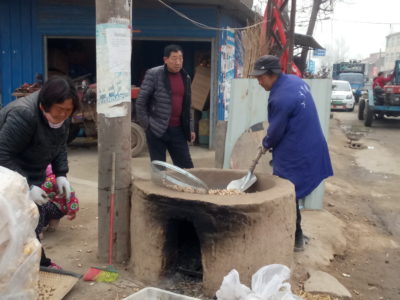
I took some new county roads, and one “T”ed in a village with a lively winter market going on that consisted mostly of super-thick under layers, comforters, and coats. Most indoor spaces are minimally heated and many people and businesses like to leave doors open, using instead hanging flaps of padded insulation to keep out the weather. If your hands are full you don’t have to struggle with opening a door, but the pervasive cold makes thick under layers a must. At the end of the street of market stalls I slipped behind a tent to consult my map, and when I looked up there where 20 pairs of eyes on me, so I waved and rolled off. Winter market season is upon us, making passage through some villages challenging.
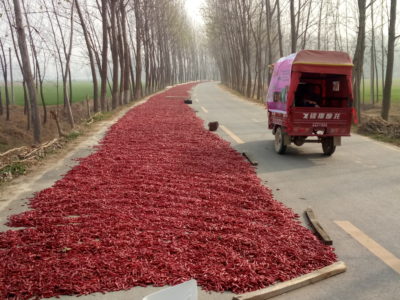
Sunday’s ride to Taikang was warmer, the temperature was great, up to about 50 degrees, but the air quality was awful. I always check it in the morning and the app said it was 162 ppm. Not great, but quite manageable with my mask. Good is under 50. As I rode along I noticed it seemed a lot smokier than 162 should look. Steve and I have gotten so that we can step out on the balcony in the morning, take a whiff and eyeball the haze and guess to within about ten points the air quality. It should have been a sunny day but the light was almost dim. Still, the countryside was beautiful and I barely saw any fires, meaning it was blowing in from somewhere else. Air quality can change quickly. In the space of an hour a change of wind direction can bring in a smog front or blow it elsewhere. That’s what happened Sunday. When I arrived back home and checked, I saw the air was at 382ppm.
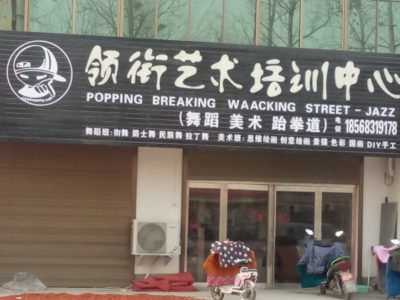
Taikang is an old city, currently retrofitting a lot of public utilities into a tight downtown area, and surrounded by wide new beltway. There were many mysterious underground stairway entrances that looked like they would have gone to a subway if Taikang were large enough to have one. Underpasses to the other side of the street? Underground shopping mall? I’ll have to check next time. It was was dark down there and I wasn’t curious enough. I found the Dico’s for coffee and after a short loop of downtown, started back.
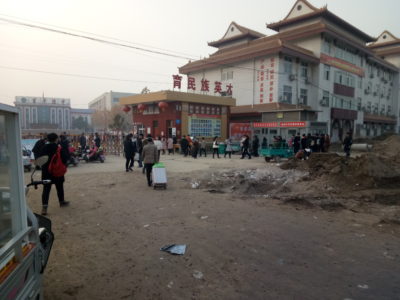
Huaiyang is doing the same major utilities retrofitting in the area I rode through on the return trip. Considering that some of these population centers may be 6000 or even 8000 years old, it’s simply more of the constant churning of demolition and reconstruction that has been a part of life here for millenia. It would be interesting to know what they’ve dug up.
This created massive traffic jams as students were being dropped off to boarding schools after a weekend home, each pulling what I expect was a suitcase of clean laundry. Smaller towns and villages lack high schools and the Huaiyang schools have a good reputation. Students everywhere here often have to leave home to attend school in the city for other reasons, too. Their parents may be working in a factory on the coast so children have to board at a school. They may stay with grandparents. Migrant factory workers cannot bring their children with them or enroll them in schools in the cities where they work. Many of my students grew up this way.
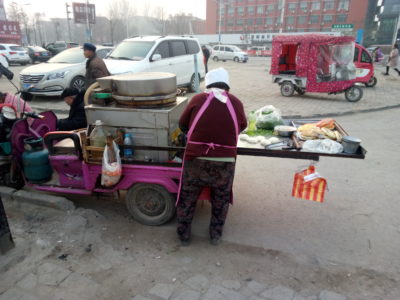
After a bite in Huaiyang I made it home with the last of the daylight. I’d wanted an even hundred miles and didn’t feel tired, but with the sore throat I felt developing, maybe from that air even with a mask, decided 87 was going to have to be enough. Maybe I’ll find out about those undergound stairways next week.

The photo of chiles drying in the road is beautiful. Happy exploring!
While Janine is out on long bike rides on Sundays, I remain on campus for Sunday afternoon baseball games. Though baseball is popular in Japan, it is not commonly known in China. The learning curve is high and there is little time and little space to play the game on campus. Still, it is fun to see how the students are able to adapt the game to a level and style reflective of their skill and interest.